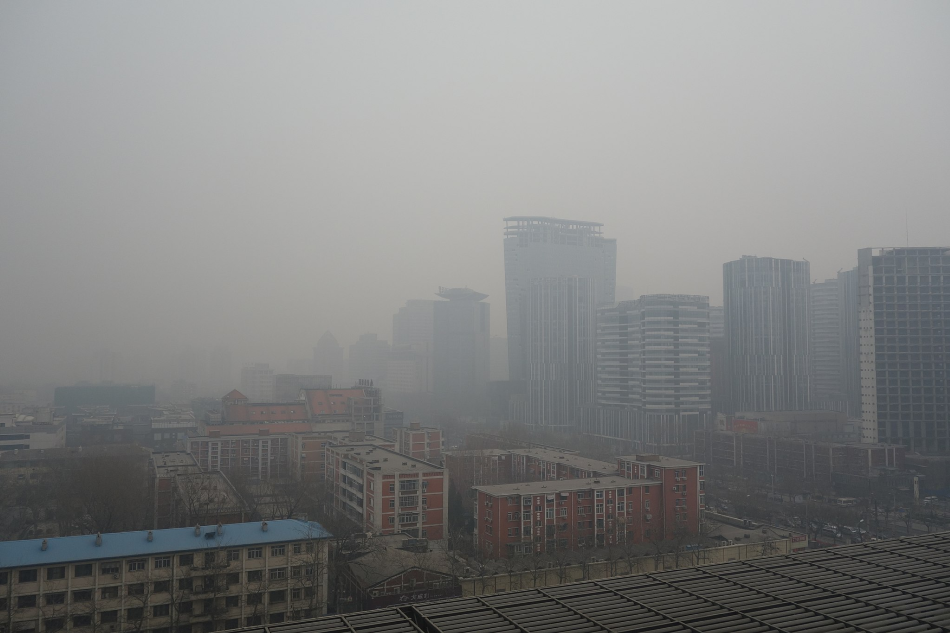May 12 2020
According to a new study, ever since lockdowns were enforced in response to the COVID-19 outbreak, the levels of two main air pollutants have reduced significantly; however, ground-level ozone—a secondary pollutant—has substantially increased in China.
 Air pollution over Beijing, China in February 2014. Two new studies show air quality has significantly improved in China due to the COVID-19 lockdowns. Image Credit: Kentaro Iemoto, CC-2.0.
Air pollution over Beijing, China in February 2014. Two new studies show air quality has significantly improved in China due to the COVID-19 lockdowns. Image Credit: Kentaro Iemoto, CC-2.0.
Two recent studies have discovered that nitrogen dioxide pollution across the United States, Western Europe, and northern China has reduced by as much as 60% in early 2020, when compared to the same time in the previous year. The studies were published in American Geophysical Union’s (AGU) journal, Geophysical Research Letters.
Nitrogen dioxide is known to be highly reactive and is generated at the time of combustion. It causes several harmful effects on the lungs. This gas usually enters the air via emissions from industrial activities, power plants, and vehicles.
Apart from nitrogen dioxide, one recent study has discovered that in northern China, particulate matter pollution (that is, particles measuring smaller than 2.5 µm) has reduced by 35%. Particulate matter is made up of liquid droplets and solid particles that are so minute that it can enter deep into the lungs and cause damage.
Both the new articles are part of an ongoing special collection of research reported in AGU journals in relation to the present COVID-19 pandemic.
According to Jenny Stavrakou, the study’s co-author and atmospheric scientist at the Royal Belgian Institute for Space Aeronomy in Brussels, such a dramatic reduction in emissions is rather extraordinary ever since the initiation of air quality monitoring from satellites in the 1990s.
The only other similar event when China experienced short-term emission reductions was during the 2008 Beijing Olympics event during which stringent regulations were enforced.
According to the scientists, while air quality improvements will probably be temporary, the findings provide researchers a glimpse of the type of air quality and how it is likely to be in the coming days, as emission regulations become more rigorous.
Maybe this unintended experiment could be used to understand better the emission regulations. It is some positive news among a very tragic situation.
Jenny Stavrakou, Study Co-Author and Atmospheric Scientist, Royal Belgian Institute for Space Aeronomy
But according to one of the latest studies, the reduction in nitrogen dioxide pollution has increased China’s surface ozone levels. Ozone—a secondary pollutant—forms when chemical reactions in the lower atmosphere are catalyzed by high temperature and sunlight. At ground-level, ozone is harmful to human beings and leads to heart and pulmonary disease.
In densely polluted regions, especially in winter, nitrogen oxide destroys the surface ozone; hence, nitrogen dioxide pollution is inversely proportional to the ozone levels.
According to Guy Brasseur, a lead author of one of the recent studies and atmospheric scientist at the Max Planck Institute for Meteorology in Hamburg, Germany, while air quality has considerably improved in several areas, surface ozone can still continue to pose a risk.
It means that by just reducing the [nitrogen dioxide] and the particles, you won’t solve the ozone problem.
Guy Brasseur, Study Lead Author and Atmospheric Scientist, Max Planck Institute
Worldwide Emissions
Along with her collaborators, Stavrakou used satellite measurements of air quality to predict the changes in nitrogen dioxide pollution across the main epicenters of the COVID-19 outbreak—China, Italy, South Korea, the United States, Iran, Germany, France, and Spain.
The researchers discovered that the nitrogen dioxide pollution is less by an average of 40% across Chinese cities and by 20% to 38% across Western Europe and the United States during the 2020 lockdown, as opposed to the same period in 2019.
But the study found that in Iran, one of the hardest and earliest-hit nations, there was no reduction in nitrogen dioxide pollution. The authors believe that this was because complete lockdowns were not implemented until late March and before that time, stay-at-home orders were mostly unheeded. But after March 20, the study’s authors did observe a drop in emissions during the Iranian New Year holiday but this reduction is seen during the celebration each year.
Air Quality in China
The second analysis examined air quality variations in northern China where the virus was initially reported and where there were the strictest lockdowns. Brasseur assessed the concentrations of nitrogen dioxide and many other types of air pollutants, quantified by 800 ground-level air quality monitoring stations located in northern China.
Along with his collaborators, Brasseur found that nitrogen dioxide reduced by an average of 60% and particulate matter pollution reduced by an average of 35% after the lockdowns were enforced on January 23rd, 2020. But the team also found that there was an increase in the average surface ozone concentration by a factor of 1.5-2 over the same period of time.
At ground level, ozone develops from a complex reaction, involving nitrogen dioxide as well as volatile organic compounds (VOCs), which are gases produced by a wide range of industrial and household products, but weather conditions and other factors can also affect ozone concentrations.
Journal Reference:
Bauwens, M., et al. (2020) Impact of coronavirus outbreak on NO2 pollution assessed using TROPOMI and OMI observations. Geophysical Research Letters. doi.org/10.1029/2020GL087978.